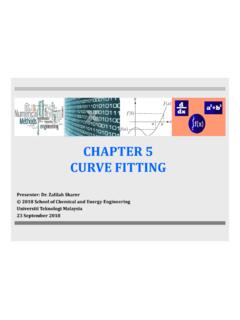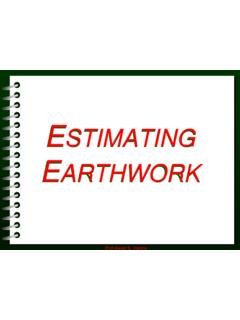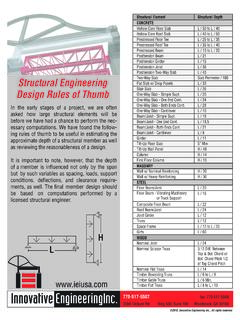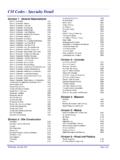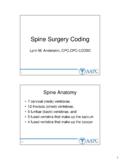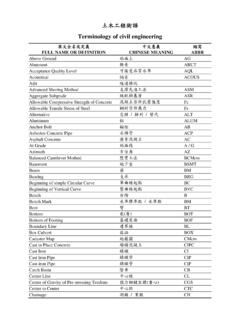Transcription of DESIGN OF RETAINING WALLS
1 DESIGN OF RETAINING IbrahimFaculty of Civil EngineeringUniversiti Teknologi MalaysiaEmail: RETAINING wall is used to retain earth or other material in vertical (or nearly vertical)position at locations where an abrupt change in ground level occurs Prevent the retained earthfrom assuming its natural angle of repose The retained earth exerts lateral pressureon the wall overturn, slide & settlement The wall must be DESIGN to be stableunder the effects of lateral pressureIntroductionSlidingSettlementOve rturningFailure in RETAINING WallTypes of RETAINING WallsGravity Wall Depends entirely on its own weightto provide necessary stability Usually constructed of plain concrete or stone masonry Plain concrete gravity wall height 3 m In designing this wall.
2 Must keep the thrust line within the middle third of the base width no tensile stress to be developedTypes of RETAINING WallsCantilever Wall Economical for height of up to 8 m Structure consist of a vertical cantilever spanning from a large rigid base slab Stabilityis maintained essentially by the weight of the soil on the base slab + self weight of structureLarge rigid baseTypes of RETAINING WallsCounterfort Wall When the overall height of the wall is too large to be constructed economically as a cantilever Wall & base are tied together at intervals by counterfort or bracingwalls Bracing in tension Economical for high wall usually above 6 7 m of backfillTypes of RETAINING WallsButtress Wall Similar to counterfort wall, but bracing is constructed in frontof the wall Bracing in compression More efficient than counterforts, but no usablespace in front of the wallTypes of RETAINING WallsGabion Wall Made of rectangular containers Fabricated of heavily galvanized wire, filled with stone and stacked on one another, usually in tiers that step back with the slope Advantages.
3 Conform to ground movement, dissipate energy from flowing water & drain-freelyTypes of RETAINING WallsCrib Wall Interlockingindividual boxes made from timber or precast concrete members Boxes are filled with crushed stone or other granular materials to create free-draining structureTypes of RETAINING WallsTieback Wall Tieback is a horizontal wire or rod, or a helical anchor use to reinforce RETAINING wall for stability One end of the tieback is secured to the wall, while the other end is anchored to a stable structure concrete deadmandriven into the ground or anchored into the earth with sufficient resistance Tieback-deadmanstructure resists forces that will cause the wall to leanTypes of RETAINING WallsKeystone Wall Made up of segmental block units, made to last Based around a system with interlocking fibreglasspins connecting the wall unit and soil reinforcement Combination of these resulted in a strong, stable and durable wall system Offers aesthetic appeal, cost efficiency.
4 Easy installation & strengthAnalysis & DesignStability AnalysisOverturn, Slide & SettleStability check under ultimate limit state: EQU, STR & GEOS ection DesignMoment DesignCheck for ShearStability Analysis(1) Overturning Occurs because of unbalanced moment When overturning moment about toe to due lateral pressure resisting moment of self weight of wall & weight of soil above the heel slab Critical condition occur when maximum horizontal force acts with minimum vertical loado f= to the permanent vertical load, Vk, which is favourable o f= to the permanent earth loading, Hkat rear face of the wall, which is unfavourable o f= to variable surcharge loading (if any)
5 , which is unfavourable Stability Analysis(1) Overturning (continued)SurchargeHk VkyxStability Criteria: or . Stability Analysis(2) Sliding Resistance against sliding provided by frictionbetween the bottom surface of the base slab and soil beneath Resistance provided by passive earth pressureon the front face of the base gives some contribution (often ignored because it is often backfilled)o f= to the permanent vertical load, Vk, which is favourable o f= to the permanent earth loading, Hkat rear face of the wall, which is unfavourable o f= to variable surcharge loading (if any), which is unfavourable Stability Analysis(2) Sliding (continued)
6 SurchargeHk VkStability Criteria: or . Stability Analysis(3) Settlement Width of base slab must be adequateto distribute the vertical force to the foundation soil To determine the required size of base, bearing pressure underneath is assessed on the basis of the ultimate limit state (GEO) Since the base slab of the wall is subjected to the combined effects of an eccentric vertical coupled with an overturning moment, the analysis is similar to that of foundation designStability Analysis(3) Settlement (continued)SurchargeHk VkyxStability Criteria:The maximum bearing pressure Soil bearing capacityePmaxPmin = = where.
7 = + A= Area of base slabe= EccentricityZ= Section modulus of base about the centroidalaxisStability Analysis(3) Settlement (continued)Ultimate Limit State (ULS)Load Combination 1 Load Combination 2 Moment due to horizontal load on the maximum bearing pressure at the toe of wall is unfavourable Moment due to weight of wall and earth acting on the heel of wall act in the opposite direction are favourable o f= weight of wall & soilo f= 0for weight of surchargeo f= lateral earth pressureo f= lateral surchargeo f= permanent action of both unfavourable & favourable effectso f= variable action of unfavourable effecto f= 0for variable action of favourable effectElement DESIGN & DetailingHorizontal pressureNet downward
8 PressureNet upwardStemHeel slabToe slabElement DESIGN & Detailing Three elements of RETAINING wall: Stem, Toe slab& Heel slabare designed as cantilever slab Stem: Designed to resist moment caused by force fHk( f= load combination 1) Toe Slab: Net pressure is obtained by deducting the weight of concrete in the toe slab from upward acting soil pressure Heel slab: Designed to resist moment due to downward pressure from the weight of retained earth (plus surcharge, if any) and concrete slab Safety factor f1, 2and f3should be considered to provide a combination which gives the critical DESIGN conditions(worst combination of 1 & 2) Temperature & shrinkage reinforcementshould be provided transverse to the main reinforcement & near the front face of the stemExample 1 CANTILEVER RC RETAINING WALLE xample 1.
9 Cantilever RC RETAINING Wall Well drained sand, soil= 19 kN/m3 Angle of internal friction, = 35 Cohesion, c= 0 Safe bearing pressure, q= 200 kN/m2 Coefficient of friction with concrete, = kN/m24000 mm500 fck= 30 N/mm2 fyk= 500 N/mm2 conc= 25 kN/m3 Concrete cover = 45 mm Bar diameter, bar= 12 mmSuggest Suitable Dimensions for the RC RETAINING WallExample 1: Cantilever RC RETAINING Wall10 kN/m24000 mm500 mmh = 240h= 4002h= 800B= 3200H= kN/m2 Active Soil Pressure, PSuggest Suitable Dimensions for the RC RETAINING WallExample 1: Cantilever RC RETAINING kN/m2 Active Soil Pressure, = + where =1 sin 1+sin =1 sin351+sin35= =19 + + H= 0 m kN/m2At H= m kN/m2At H= m kN/m2 Taking Moment at Point AExample 1: Cantilever RC RETAINING Wall10 kN/m24000 mm500 mmh = 240h= 4002h= 800B= 3200H= kNStability AnalysisExample 1: Cantilever RC RETAINING WallElementLoad (kN)Lever Arm(m)Moment at Point A(kNm)Wall1.
10 ( 1m width) = ( 1 m width) = ( 1 m width) = ( 1m width) ( 1m width) = Pressure Surcharge ( 1m width) = ( ) ( 1m width) = ,MPermanent =Variable= Load, VkPermanent = , HkPermanent = Analysis1. Stability Against Overturning (at point A):Check . Overturning Moment = ( ) + ( ) = 160 kNmRestraining Moment = ( ) + (0 ) = 418 kNmSince Overturning Moment Restraining Moment OKExample 1: Cantilever RC RETAINING WallStability Analysis (continued)2. SlidingCheck . =Sliding Force = ( ) + ( ) = 103 kNFriction Force = [( ) + (0 )] = 108 kNSince Sliding Force Friction Force OKExample 1: Cantilever RC RETAINING WallStability Analysis (continued)3.




